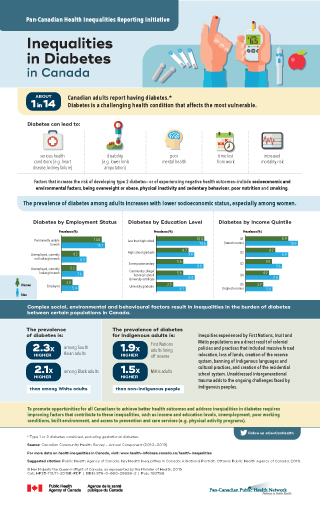Infographic: Inequalities in diabetes in Canada

Download the alternative format
(PDF format, 1.25 MB, 1 page)
Organization: Public Health Agency of Canada
- Cat.: HP35-113/11-2019E-PDF
- ISBN: 978-0-660-29698-2
- Pub.: 180786
Pan-Canadian Health Inequalities Reporting Initiative
Inequalities in Diabetes in Canada
About 1 in 14 Canadian adults report having diabetes.Footnote *
Diabetes is a challenging health condition that affects the most vulnerable.
Diabetes can lead to:
- serious health conditions (e.g. heart disease, kidney failure)
- disability (e.g. lower limb amputation)
- poor mental health
- time lost from work
- increased mortality risk
Factors that increase the risk of developing type 2 diabetes— or of experiencing negative health outcomes—include socioeconomic and environmental factors, being overweight or obese, physical inactivity and sedentary behaviour, poor nutrition and smoking.
The prevalence of diabetes among adults increases with lower socioeconomic status, especially among women.
| Employment status | Prevalence (%) | |
|---|---|---|
| Women | Men | |
| Permanently unable to work | 14.0 | 15.1 |
| Unemployed, currently not looking for work | 6.2 | 8.7 |
| Unemployed, currently looking for work | 5.2 | 7.6 |
| Employed | 3.8 | 5.9 |
| Education level | Prevalence (%) | |
|---|---|---|
| Women | Men | |
| Less than high school | 10.0 | 10.6 |
| High school graduate | 6.7 | 7.9 |
| Some postsecondary | 5.6 | 9.8 |
| Community college/Technical school/University certificate | 5.6 | 8.0 |
| University graduate | 3.5 | 6.1 |
| Income quintile | Prevalence (%) | |
|---|---|---|
| Women | Men | |
| Q1 (lowest income) | 8.9 | 10.9 |
| Q2 | 6.2 | 8.9 |
| Q3 | 5.5 | 7.6 |
| Q4 | 4.9 | 7.0 |
| Q5 (highest income) | 3.7 | 5.6 |
Complex social, environmental and behavioural factors result in inequalities in the burden of diabetes between certain populations in Canada.
The prevalence of diabetes is:
- 2.3 times higher among South Asian adults
- 2.1 times higher among Blacks adults
- than among White adults
The prevalence of diabetes for Indigenous adults is:
- First Nations adults living off reserve
- 1.9 times higher
- Métis adults
- 1.5 times higher
- than that of non-Indigenous adults
Inequities experienced by First Nations, Inuit and Métis populations are a direct result of colonial policies and practices that included massive forced relocation, loss of lands, creation of the reserve system, banning of Indigenous languages and cultural practices, and creation of the residential school system. Unaddressed intergenerational trauma adds to the ongoing challenges faced by Indigenous peoples.
To promote opportunities for all Canadians to achieve better health outcomes and address inequalities in diabetes requires improving factors that contribute to these inequalities, such as income and education levels, unemployment, poor working conditions, built environment, and access to prevention and care services (e.g. physical activity programs).
Follow us @GovCanHealth
Source: Canadian Community Health Survey - Annual Component (2010-2013)
For more data on health inequalities in Canada, visit:
www.health-infobase.canada.ca/health-inequalities
Suggested citation: Public Health Agency of Canada. Key Health Inequalities in Canada: A National Portrait. Ottawa: Public Health Agency of Canada; 2018.
© Her Majesty the Queen in Right of Canada, as represented by the Minister of Health, 2019 | Cat.: HP35-113/11-2019E-PDF | ISBN: 978-0-660-29698-2 | Pub.: 180786